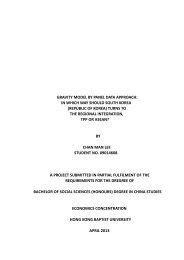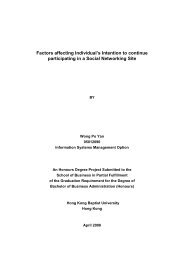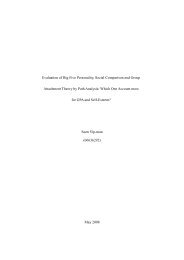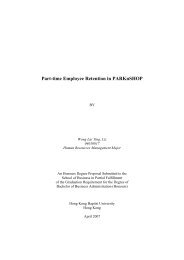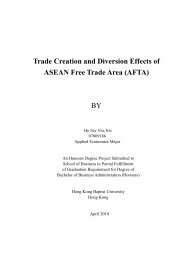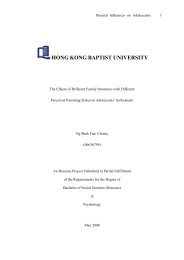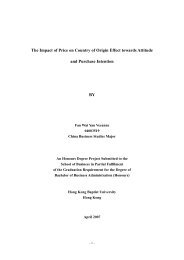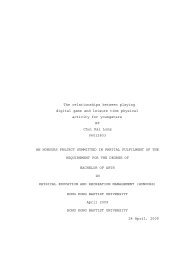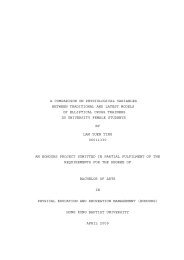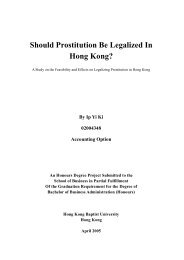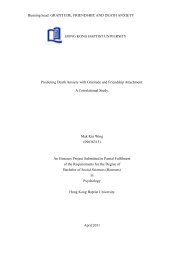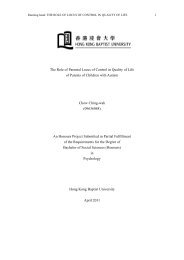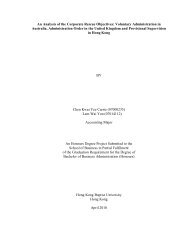honours project final - Hong Kong Baptist University
honours project final - Hong Kong Baptist University
honours project final - Hong Kong Baptist University
Create successful ePaper yourself
Turn your PDF publications into a flip-book with our unique Google optimized e-Paper software.
Electronic Word-of-Mouth Adoption within Blog Platform:<br />
Factors Affecting Blog Readers to Adopt Information<br />
BY<br />
Au-Yeung Ying Lun<br />
08023468<br />
Sit Sze Wan<br />
08020345<br />
Information System Management Major<br />
An Honours Degree Project Submitted to the<br />
School of Business in Partial Fulfilment<br />
of the Graduation Requirement for the Degree of<br />
Bachelor of Business Administration(Honours)<br />
<strong>Hong</strong> <strong>Kong</strong> <strong>Baptist</strong> <strong>University</strong><br />
<strong>Hong</strong> <strong>Kong</strong><br />
April 2010
Factors Affecting Blog Readers to Adopt Information<br />
Acknowledgements<br />
We would like to take this opportunity to express our sincere gratitude to our supervisor, Dr.<br />
Christy, M.K. Cheung. Her priceless advices, guidance and support provides us insights into<br />
the <strong>project</strong> and encouraged us to take up the challenges from that.<br />
Special thanks will also be granted to Mr. Damon Chan, the administrator of 3CMusic.com,<br />
who spared his time handling our requests and giving us the technical or other supports on<br />
helping us to attract more survey participation.<br />
Also, We would like to take this opportunity to thank all the respondents who spent their valuable<br />
time to fill the questionnaire. Their cooperation was critical in accomplishing our research<br />
goals.<br />
Finally, working on this <strong>project</strong> is a solitary and prolonged war, our heartfelt thanks go to my<br />
beloved classmates, friends and parents for their support and encouragement.<br />
ii
Factors Affecting Blog Readers to Adopt Information<br />
Abstract<br />
With the growing popularity of writing blogs as the way to share out personal comments to the<br />
Internet, new forms of promotion opportunities arise as the blogs are pretty good vehicles to<br />
transport these electronic word-of-mouth(eWOM) information around the forums or socialnetworking<br />
sites. And so, we would like to ponder into the question on how these blog readers<br />
everywhere adopt these eWOM information? What are the factors that can encourage people<br />
to adopt what is told by a blogger?<br />
To complete this task, a new set of research model is proposed and questionnaires are made.<br />
The whole survey collected responds from 209 people, and all these data are to be analysed using<br />
PLS.<br />
from Mashable.com<br />
The research result showed that eWOM adoption in<br />
blogging context largely depends on argument quality<br />
the bloggers and contributors can offer, and argument<br />
quality is closely related with message comprehensiveness,<br />
accuracy, argument strength, as well as recommendation<br />
consistency from blog comments or ratings.<br />
This research paper provides insights and directions<br />
to both individual and corporate bloggers, as well as marketing and PR practitioners on<br />
how to utilise the advantages from blogging.<br />
iii
Factors Affecting Blog Readers to Adopt Information<br />
TABLE OF CONTENTS<br />
Title & Introduction! 1<br />
Research Title! 1<br />
Research Background! 1<br />
Research Objective! 2<br />
Literature Review! 3<br />
Electronic World of Mouth(eWOM)! 3<br />
Weblog(Blog) as a source of eWOM! 4<br />
Information Adoption Model! 5<br />
Elaboration Likelihood Model(ELM)! 5<br />
Dual-process Theory! 6<br />
Research Model and Hypothesis! 7<br />
Effect of argument quality and perceived source credibility on eWOM adoption &om blog platform! 8<br />
Factors affecting argument quality! 8<br />
Factors affecting source credibility! 10<br />
Research Methodology! 12<br />
iv
Factors Affecting Blog Readers to Adopt Information<br />
Data Co'ection! 13<br />
Survey Responses! 14<br />
Measures! 18<br />
Data Analysis And Results! 19<br />
Measurement Model! 19<br />
Convergent validity! 19<br />
Discriminant Validity! 22<br />
Structural Model! 23<br />
Discussion of research results! 26<br />
eWOM Adoption of Blog Platform! 26<br />
Adopting anonymous messages: shi( away &om trusting "authorities"! 26<br />
Determinants on Argument Quality of Blog Posts! 27<br />
Factors affecting Source Credibility of a Blog! 29<br />
Conclusion! 29<br />
Limitations and Future Research! 30<br />
Implication for research and real-world contexts! 31<br />
v
Factors Affecting Blog Readers to Adopt Information<br />
Implication for Researchers! 31<br />
Implication for Blo)ers and Business Organisations! 31<br />
References! 33<br />
Appendix! 37<br />
Appendix 1 Measurement table! 38<br />
Appendix 2 Questionnaire Sample(Chinese and English Bi-lingual Version)! 41<br />
vi
Factors Affecting Blog Readers to Adopt Information<br />
Title & Introduction<br />
R ESEARCH T ITLE<br />
Electronic Word-of-Mouth Adoption within Blog Platform: Factors Affecting Blog Readers to<br />
Adopt Information<br />
Research Background<br />
Blogs are an increasingly popular in the Internet. According to statistic results from blog search engine<br />
Technorati, as of June 2008, about 10 years after the term was invented, 112.8 million blogs<br />
have been indexed by this web company. At the same time, blogs are generating a great deal of<br />
web traffic and public influence that is comparable, or sometimes even exceeding, what traditional<br />
media can deliver to. According to China Daily(2006), the world's most popular blog,<br />
written by Chinese actress Xu Jinglei() received more than 50 million page views. In<br />
<strong>Hong</strong> <strong>Kong</strong>, there are already 418,183 blogs written by local people(Mok, 2007).<br />
Electronic world of mouth is regarded as an important factor affecting consumers' buying decision<br />
making process. In collaboration with brands’ own websites, message boards and social<br />
networking sites(e.g. facebook.com), etc., these web systems are served as major platforms for<br />
customer contribution and discussion of any consumer products Nowadays. And clearly, since<br />
blogs have such an effective and easy-to-share platform to share these information, we shall<br />
find out the new ways to influence customers' believe and attitude.<br />
In fact, there are growing numbers of advertisers compensate consumers to review their products<br />
in personal blogs(Werde, 2003; Blackshaw, 2006). In addition, there are some recent re-<br />
1
Factors Affecting Blog Readers to Adopt Information<br />
searches on word of mouth marketing over the new media that proved the importance of blog<br />
in this new wave of media. According to Lee and Youn's research paper(2009), when compared<br />
to other platforms including marketer's websites, eWOM posted to personal blogs are more<br />
likely to be attributed to the product’s actual performance and thus more influential because<br />
personal blogs are supposed to be more independent of marketers’ selling intents. The blog<br />
posts are actually serving as the key pivoting many viral effects, since it has all the contents for<br />
sharing out to all the rest web 2.0 tools.<br />
Therefore, these recent phenomenons raise an interesting question to study: what are the factors<br />
that drives information adoption on this electronic platform, and to accomplish the objectives<br />
that cannot be done by other media platforms.<br />
Research Objective<br />
The purpose of the current study is to examine how blog readers evaluate and trust the message<br />
from a blog by discovering and testing which factors encourage information(eWOM)<br />
adoption inside a blog platform. Since we found out that instead of traditional advertising,<br />
people are trusting the testimonials from a blogger much more, we want to uncover the ways how<br />
people digest these blog messages and to convert them to WOM information, by adopting research<br />
models such as Information Adoption Model, Elaboration Likelihood Model, as well as the<br />
Dual Process Theory. We believe that his study shall provide some useful inspirations for individual<br />
and corporate bloggers, as well as organisational and corporate clients to help better<br />
managing the online appearances and popularity of the individuals themselves, as well as the<br />
products/services offered by them.<br />
2
Factors Affecting Blog Readers to Adopt Information<br />
Literature Review<br />
In this literature review, we will first introduce the theoretical background of the electronic<br />
world of mouth(eWOM), research models like Information Adoption Model, Elaboration<br />
Likelihood Model as well as Dual Process Theory. With these theories and models we will<br />
cover how various factors might affect the eWOM adoption. We will also examine the relevant<br />
literature relating to eWOM adoption, argument quality and source credibility of a message.<br />
E LECTRONIC W ORLD OF M OUTH( E WOM)<br />
Electronic world of mouth, just like the word it is originated from(WOM), is regarded as an<br />
important element for affecting consumers' buying decision making process. Electronic wordof-mouth(eWOM)<br />
communication refers to any positive or negative statement made by potential,<br />
actual, or former customers about a product or company, which is made available to a<br />
multitude of people and institutions via the Internet(Hennig-Thurau etal.,2004).<br />
The biggest difference between the traditional world of mouth and eWOM is that eWOM is<br />
in electronic form and without a face to face interaction with other people. The world of<br />
eWOM was created as the emergence of internet allows consumers to collect and spread<br />
products or services information from and to other consumers through viewing<br />
webpage(Hennig-Thurau etal.,2004). The convenience brings from eWOM is that it can help<br />
people to gather more information during their information search stage and highly reduce<br />
their searching cost.<br />
Besides the effectiveness from electronic transmission, another important observation about<br />
eWOM in this decade is that people seems adopting eWOM information differently. We can<br />
3
Factors Affecting Blog Readers to Adopt Information<br />
observe such changes by reading a quote from the latest Nielsen Global Online Consumer Survey<br />
of over 25,000 Internet consumers from 50 countries(2009):<br />
"Consumers Trust Real Friends and Virtual Strangers the Most."<br />
It is reported from the result of the above survey that, ninety percent of consumers surveyed<br />
noted that they trust recommendations from people they know, while 70 percent trusted consumer<br />
opinions posted online, without any prior knowledge of who the writer is. On the next<br />
paragraph, we are going to discuss the fact that blogs can be the vehicles for transmitting these<br />
eWOM information.<br />
W EBLOG(BLOG) AS A SOURCE OF EWOM<br />
Blogs remains an increasingly popular culture in the Internet world a decade after the invention<br />
of the original term "weblog" by Jorn Barger on 17 December 1997. The term "blog" is<br />
short for "weblog". It is essentially an online journal where the author("blogger") often starts a<br />
conversation that can be continued by readers. Blog journal entries are generally short and include<br />
links to related information. Blogs can also be used to communicate news and announcements<br />
from multiple sources faster than other media outlets(Anders, 2007).<br />
Being described as an effective platform to influence customers' believe and attitude, these<br />
communicators(i.e. bloggers) in fact occasionally post product review information on blogs –<br />
websites that contain personal diaries or journals(Thorson & rodgers, 2006). From the latest<br />
findings and discussions mentioned at the previous section, we are very interested in the fact<br />
that people simply trust bloggers more than they trust advertising, in a way just almost as personal<br />
as your friends(Nielsen 2009).<br />
4
Factors Affecting Blog Readers to Adopt Information<br />
Base on the preceding discussions, we would like to ponder over the phenomenon of consumers'<br />
treatment of these eWOM messages. Our research model is largely based on the information<br />
adoption model(Sussman and Siegal, 2003), elaboration likelihood model(ELM)(Petty and<br />
Cacioppo, 1986; Chaiken and Eagly, 1976) and Deutsch and Gerrard’s dual-process theory(1955).<br />
I NFORMATION A DOPTION M ODEL<br />
Pitta and Fowler(2005) suggested that a process in which people purposefully engage in using<br />
information. Information adoption behaviour is one of the principle activities that users seek<br />
to conduct in virtual communities. Sussman and Siegal(2003) suggests that the above process<br />
has two key propositions: argument quality(information quality) as the central influence<br />
and source credibility as the peripheral influence(Sussman and Siegal, 2003). Figure 1 below<br />
presents the information adoption model.<br />
Figure 1: the research model from Sussman and Siegal’s research paper<br />
E LABORATION L IKELIHOOD M ODEL(ELM)<br />
Sussman and Siegal also adopted the elaboration likelihood model(ELM) to explain how people<br />
are influenced to adopt information appeared in computer-mediated communication(CMC)<br />
contexts which is centrally and peripherally influence people's attitude and behavior.<br />
5
Factors Affecting Blog Readers to Adopt Information<br />
Centrally refers to the nature of argument in the message whereas peripherally refers to the<br />
issues and theme indirectly related to subject matter of the message(Petty and Cacioppo,1986).<br />
According to elaboration likelihood model(Petty and Cacioppo, 1986; Chaiken and Eagly,<br />
1976), we understand the two major routes human process the messages they receive. In fact,<br />
this model served as the foundation of the Information Adoption Model, and enables us to<br />
make predictions about the relative impact of various factors on information adoption(Sussman<br />
and Siegal, 2003).<br />
D UAL- PROCESS T HEORY<br />
From the preceding 2 paragraphs, we can understand that researchers tend to categorise factors<br />
influencing our information processing into two major "routes"(normative factors vs. informational<br />
factors). The Dual-process theory also gives similar insights to us. When people receive<br />
the same information, their degree of the information adoption may be different(Chaiken and<br />
Eagly,1976), due to people with different characteristics, personalities, perceptions, experience<br />
and sources. Thus, dual process theories are used to explain why people have difference in<br />
adopting information, idea and knowledge(Sussman and Siegal, 2003; Bhattacherjee and Sanford,<br />
2006). Dual-process theory(Deutsch and Gerrard, 1955) considers how different types of<br />
influences affect the persuasiveness of on-line consumer reviews. Informational influence is<br />
based on the content of the reviews, whereas normative influence reflects the impact of social<br />
aggregation mechanisms available in today’s on-line consumer forums.(Cheung, Luo, Sia, and<br />
Chen's research, 2009)<br />
6
Factors Affecting Blog Readers to Adopt Information<br />
Research Model and Hypothesis<br />
Figure 2 below shows the research model we propose for this study, which explains the determinants<br />
of eWOM adoption level in blog platform, based on the information adoption model<br />
and elaboration likelihood model(ELM). Our model is also inspired by Cheung, Lee and Rabjohn's<br />
research paper(2008) studying online opinion adoption. In addition, Cheung, Luo, Sia,<br />
and Chen's research(2009) used Deutsch and Gerrard’s dual-process theory(1955) which depicted<br />
that both informational and normative factors that influence credibility judgments of<br />
on-line consumer recommendations, and we try to implement the normative influences into<br />
the model.<br />
Figure 2: the research model<br />
7
Factors Affecting Blog Readers to Adopt Information<br />
E FFECT OF ARGUMENT QUALITY AND PERCEIVED<br />
SOURCE CREDIBILITY ON EWOM ADOPTION FROM<br />
BLOG PLATFORM<br />
The information adoption model(Sussman and Siegal, 2003), as a form of information, eWOM<br />
shall be adopted based on information usefulness which is affected by both central(argument<br />
quality) and peripheral(source credibility) influences. Also, according to Cheung, Luo, Sia, and<br />
Chen's research model(2009), source credibility and argument strength are vital factors that<br />
were found to play a significant role in communication judgment.<br />
In the context of blogging, since most of the blogs are article-based, we believe that it is suitable<br />
to adopt the above information model into it. In other words, people shall judging that<br />
particular piece of blog message base on either what the blo#er has written actua$y, or who the blogger<br />
is. Therefore, our research model propose that the adoption of eWOM from blog sites<br />
should be positively related with argument quality as well as source credibility of the blog<br />
message:<br />
HYPOTHESIS 1. The higher the perceived argument quality of an eWOM message from a<br />
blog, the higher level of adoption of the eWOM message will be achieved.<br />
HYPOTHESIS 2. The higher the perceived source credibility of an eWOM message from a<br />
blog, the higher level of adoption of the eWOM message will be achieved.<br />
F ACTORS AFFECTING ARGUMENT QUALITY<br />
Determined by the perceived quality of information and recommendation, argument quality is<br />
considered as the central influences of the blog message adoption. We borrowed several factors from<br />
Cheung, Lee and Rabjohn's research(2008)(accuracy and comprehensiveness) and Cheung,<br />
8
Factors Affecting Blog Readers to Adopt Information<br />
Luo, Sia, and Chen's research(2009)(argument strength and recommendation consistency) and<br />
made adaptions to our research model in order to fit into blogging context. Therefore, We believe<br />
that the perceived argument quality is affected by the following factors based on readers'<br />
judgement and proactive interpretations.<br />
Comprehensiveness of a blog message refers to the completeness of the recommendation/<br />
message received when viewing the blog. Cheung, Lee and Rabjohn's research(2008) suggested<br />
that the more comprehensive the messages are, the higher the perceived information usefulness<br />
of the message. Accuracy of a blog message refers to the content reliability and consistency.<br />
It also represents user’s perception that the information is correct(Wixom and Todd,<br />
2005). Argument strength of a blog message refers to the persuasiveness of the recommendation.<br />
It is the extent to which the message receiver views the argument as convincing or valid<br />
in supporting its position(Cheung, Luo, Sia, and Chen, 2009). Recommendation consistency<br />
indicates the extent to which the current eWOM recommendation is consistent with other<br />
contributors’ experiences concerning the same product or service evaluation(Zhang and Watts,<br />
2003). In our study, we would focus particularly on the blog readers' discussions following a<br />
blog message by commenting it.<br />
HYPOTHESIS 3. The higher the comprehensiveness of a blog message, the higher the argument<br />
quality will be perceived to be.<br />
HYPOTHESIS 4. The higher the accuracy of a blog message, the higher the argument quality<br />
will be perceived to be.<br />
HYPOTHESIS 5. The higher the argument strength of a blog message, the higher the argument<br />
quality will be perceived to be.<br />
9
Factors Affecting Blog Readers to Adopt Information<br />
HYPOTHESIS 6. The higher the recommendation consistency of a blog message, the<br />
higher the argument quality will be perceived to be.<br />
F ACTORS AFFECTING SOURCE CREDIBILITY<br />
In blogging context, be predict that other than the message content itself, the source of the<br />
blog shall also be considered during the adoption process. From Sussman and Siegal's paper(2003),<br />
Chaiken(1980) stated that source credibility refers to recipient's perception of the<br />
credibility of a message source, and that reflects nothing about the message itself. There are<br />
some researches suggest that source credibility played an important role in peripheral consumer<br />
judgements. In information systems research, source credibility has been shown to positively<br />
influence low-participation users' acceptance of recommendations made by knowledgebased<br />
systems(Mak and Lyytinen, 1997). On the Internet, perceptions of source credibility play<br />
an important role in our judgments of cognitive authority(Rieh and Belkin, 1998). Therefore,<br />
we believe that the perceived source credibility is affected by various factors based on readers'<br />
peripheral route, as stated by elaboration likelihood model(ELM)(Petty and Cacioppo, 1986;<br />
Chaiken and Eagly, 1976).<br />
We also tried to pick up some factors affecting source credibility and fit it into blogging context.<br />
Cheung, Lee and Rabjohn's research paper(2008) suggested that source expertise and<br />
trustworthiness are the two key dimensions of source credibility. From Fogg et al.'s paper(2001),<br />
source expertise is defined by terms such as knowledgeable, experienced, competent,<br />
and so on. The expertise dimension of credibility captures the perceived knowledge and<br />
skill of the source; and source trustworthiness dimension of credibility captures the perceived<br />
goodness or morality of the source. Trustworthiness, a key element in the credibility calculus, is<br />
defined by the terms well-intentioned, truthful, unbiased, and so on. The trustworthiness di-<br />
10
Factors Affecting Blog Readers to Adopt Information<br />
mension of credibility captures the perceived goodness or morality of the source(BJ Fogg, et al,<br />
2001). Fogg et al.'s research paper(2001) also suggested that the presence of advertisement has<br />
been negatively associated with perceived credibility. <strong>Hong</strong>(2006) also stated in her research<br />
that the presence of Web advertisements, which include hyperlink, banner and other<br />
graphically-based ads, decreases perceived Web site credibility.<br />
HYPOTHESIS 7. The higher the perceived source expertise(e.g. writer or information<br />
agency) of the blog, the higher the source credibility of the blog will be.<br />
HYPOTHESIS 8. The higher the perceived trustworthiness of a blog message source, the<br />
higher the source credibility of the blog will be.<br />
HYPOTHESIS 9. The presence of advertisement in the blog site will negatively affect the<br />
source credibility of the blog.<br />
11
Factors Affecting Blog Readers to Adopt Information<br />
Research Methodology<br />
Our research will focus on the factors affecting eWOM message adoption within blogging<br />
platform, the research model will be tested based on an existing blog site, 3C<br />
Music(http://3cmusic.com/).<br />
3CMusic.com(3C Music ) is an online platform established at year 2006. It consists<br />
of a selected group of bloggers for writing reviews on Chinese Pop Music CD Albums and<br />
Singles. Apart from giving critical comments on those CDs, the blog also shares updated information<br />
about Pop-music industry in Pan-China region.<br />
Figure 3: the front page of 3CMusic.com, a banner advertisement linking with our questionnaire<br />
is added on the centre column of the web page.<br />
12
Factors Affecting Blog Readers to Adopt Information<br />
Data Collection<br />
To examine the factors affecting eWOM adoption from the blog site, a sample in total of 209<br />
web-based questionnaires were used during the 5-week survey period starting from 19th of<br />
February, 2010. The target respondents of this research were individuals who had visited the<br />
above virtual opinion platform and are influenced by the recommendations, discussions and<br />
comments shared within the blog site.<br />
The questionnaire is divided into several parts. The extent of eWOM(recommendation) adoption<br />
was asked in the questionnaire, to see if those review information will be adopted by the<br />
blog readers or not, which may ultimately affect their buying behaviour. Demographic information<br />
was asked as well. These includes monthly income or music product purchasing habits,<br />
etc. Most of these questions shall be measured on a seven-point Likert scale.<br />
At the same time, in order to facilitate public participation of our survey, we have done the following<br />
two measures: first, we contacted the administrator of 3CMusic.com, Mr. Damon Chan<br />
to ask for reserving a space in the blog for promoting our survey, and eventually we came up<br />
with an agreement to allow us to post up a small banner advertisement asking for public contribution<br />
to our survey(as shown in figure 3 above). Also, with the support from our supervisor<br />
Dr. Christy Cheung, we held a lucky draw(using 3 supermarket coupon as the gifts) as an incentive<br />
to encourage survey participation rate. In addition, bi-lingual versions of questionnaire(Chinese<br />
and English) are used for easier understanding.<br />
13
Factors Affecting Blog Readers to Adopt Information<br />
Survey Responses<br />
A total of 209 responses were collected in this study. Among the 209 respondents, we have<br />
more than a half males participating the survey(46.15% for female), and most of the participants<br />
are in younger age group(180 out of the 209 participants are in age of 19 to 30). We had a<br />
fairly positive response from them, with only 29.81% of them haven't visited 3CMusic.com<br />
while the rest(143 people, about 70.19%) have paid visit to the web site at least for one time.<br />
Among the blog readers, almost half of them(62 out of 143 positive responds) visit the blog 5-12<br />
times a month, and almost half(59 of them) use this blog as the primary source of Chinese Music<br />
critics and news. Besides that, many respondents also use Internet forums, other private<br />
blogs, as well as radio channels as the major source of Chinese Music.<br />
In table 1 and 2, the demographic information as well as usage habits of respondents are shown.<br />
14
Factors Affecting Blog Readers to Adopt Information<br />
D EMOGRAPHIC STATISTICS OF THE RESPONDENTS<br />
M E A S U R E V A L U E F R E Q U E N C Y P E R C E N T A G E<br />
Sex Male 115 54.50%<br />
Female 96 45.50%<br />
Age 18 or below 14 6.64%<br />
19-25 156 73.93%<br />
26-30 27 12.80%<br />
31-35 9 4.27%<br />
36-44 2 0.95%<br />
45 or above 3 1.42%<br />
Educational Level Primary 0 0%<br />
Secondary 20 9.48%<br />
College 78 36.97%<br />
Undergraduate 93 44.08%<br />
Postgraduate 20 9.48%<br />
Occupation Student 128 66.66%<br />
Clerical worker 23 10.90%<br />
Professional 32 15.17%<br />
Self-employed 1 0.47%<br />
Servicing 15 7.11%<br />
Management 4 1.90%<br />
Others 8 3.79%<br />
Table 1. Demographic statistics of the respondents<br />
15
Factors Affecting Blog Readers to Adopt Information<br />
U SAGE HABIT OF THE RESPONDENTS<br />
M E A S U R E V ALUE F REQUENCY P ERCENTAGE<br />
Visited 3CMusic.com Yes 149 70.62%<br />
Period of time on<br />
reading 3CMusic<br />
Left comments experience<br />
Frequency of visiting<br />
3CMusic.com per<br />
month<br />
Set 3CMusic as home<br />
page<br />
No 62 29.38%<br />
less than a month 31 20.95%<br />
more than a month,<br />
less than 3 months<br />
more than 3 month,<br />
less than 6 months<br />
more than 6 month,<br />
less than a year<br />
more than a year, less<br />
than 2 years<br />
17 11.49%<br />
26 17.57%<br />
36 24.32%<br />
23 15.54%<br />
2 years or above 15 10.14%<br />
Yes 39 27.08%<br />
No 105 72.92%<br />
less than 1 18 12.16%<br />
1-4 31 20.95%<br />
5-8 42 28.38%<br />
9-12 21 14.19%<br />
13-16 10 6.76%<br />
17-20 9 6.08%<br />
21-24 5 3.38%<br />
25 or above 12 8.11%<br />
Yes 6 4.14%<br />
No 139 95.86%<br />
16
Factors Affecting Blog Readers to Adopt Information<br />
M E A S U R E V ALUE F REQUENCY P ERCENTAGE<br />
Add 3CMusic.com as<br />
your favourite/<br />
bookmark<br />
Subscribe<br />
3CMusic.com's RSS<br />
feed<br />
Use 3CMusic.com as<br />
the primary source<br />
Source(s) of Chinese<br />
Music critics and<br />
news<br />
Yes 83 57.42%<br />
No 62 42.76%<br />
Yes 46 31.72%<br />
No 99 68.28%<br />
Yes 59 40.69%<br />
No 86 59.31%<br />
TV 42 10.07%<br />
Radio 76 18.23%<br />
Magazine 43 10.31%<br />
Internet forums 94 22.54%<br />
Blogs 93 22.3%<br />
Social Network Sites 60 14.39%<br />
Others 9 2.16%<br />
Table 2. Usage habit of the respondents<br />
17
Factors Affecting Blog Readers to Adopt Information<br />
Measures<br />
The measure are adopted from prior research papers and questionnaires, with minor modification<br />
of wordings to fit into our research topic and contexts(studying 3CMusic blog). Multi-item<br />
measures were used, and each of the construct inside the research model was measured by<br />
multiple items for validity and reliability. Measurements for Argument Quality, Source Credibility,<br />
and Information Adoption were phrased on seven-point Likert scale, e.g. from strongly<br />
agree(1) to strongly disagree(7), seldom and frequent, reliable and not reliable.<br />
These measure are also printed in Appendix 1, while the complete set of questionnaire is attached<br />
in Appendix 2.<br />
18
Factors Affecting Blog Readers to Adopt Information<br />
Data Analysis And Results<br />
Data analysis was performed using Partial Least Squares(PLS), PLS is a structural modelling<br />
technique widely used among IS research, and it is a structural modelling technique which is<br />
for developing highly complex predictive models(Lohmoller, 1989; Barclay et al., 1995; Chin,<br />
1998). We picked up SmartPLS over similar analysis softwares like SPSS because the research<br />
models of SPSS can only have one construct linking with one construct. It allows researchers<br />
to perform regressions to analyse structural models with multiple-item-constructs and direct<br />
and indirect paths. Loadings between items and constructs, as well as standardised regression<br />
coefficients between constructs will also be analysed. Two-step analytical procedures, measurement<br />
model and structural model(Hair et al., 1998) are involved in this analysis to ensure<br />
the relationship is drawn with a desirable psychometric properties.<br />
Measurement Model<br />
C ONVERGENT VALIDITY<br />
Convergent Validity extents to which indicators(measurement items) of a specific construct<br />
coverage or share a high proportion of variance in common that is theoretically related should<br />
correlate highly. Composite Reliability(CR) is the measure of reliability and internal consistency<br />
of the measured variables representing a latent construct. Average Variance Extracted(AVE)<br />
is a summary measure of convergence among a set of items representing a latent construct,<br />
which is the average percentage of variation explained among the items. Table 2(Psychometric<br />
Properties of measures) summarises the result of the measurement model in terms<br />
of CR and AVE of the factor loadings, t-value, mean, standard deviation, composite reliability<br />
19
Factors Affecting Blog Readers to Adopt Information<br />
and average variance. The critical values of CR and AVE are 0.7 which represent sufficient convergence<br />
or internal consistency and 0.5 suggest sufficient convergent validity respectively(Fornell<br />
and Larcker, 1981). All CR and AVE values achieve the recommend levels, CR ranges from<br />
0.797 to 0.982 and the AVE ranges from 0.631 to 0.965. Loading is to test how well a measurement<br />
item can explain the latent factor where T-value is to find the significance of the measurement<br />
items. T-value supposes to be larger than 2 in orders to show significance. Loading is<br />
from 0.661 to 0.983 while t-value is from 5.44 to 240.395, both of them success to show significance.<br />
Table 3 below summarises the loading, t-value, mean, standard deviation, composite reliability<br />
and average variance extracted of measures.<br />
P SYCHOMETRIC P ROPERTIES OF M EASURES<br />
C ONSTRUCT I T E M L OADING T - VALUE M EAN S T .DEV<br />
Argument Q19 0.88 44.09 0.88 0.02<br />
Quality<br />
Q20 0.84 22.98 0.83 0.04<br />
CR=0.96, Q21 0.92 51.53 0.92 0.02<br />
AVE=0.82<br />
Q22 0.94 98.67 0.95 0.01<br />
Q23 0.94 93.23 0.94 0.01<br />
Comprehensiveness<br />
Q24 0.94 53.96 0.94 0.02<br />
Q25_R 0.67 5.44 0.65 0.12<br />
CR=0.80,<br />
AVE=0.67<br />
Accuracy Q26 0.93 63.48 0.93 0.01<br />
CR=0.96, Q27 0.95 91.91 0.96 0.01<br />
AVE= 0.89 Q28 0.94 83.73 0.94 0.01<br />
Argument<br />
Strength<br />
CR=0.96,<br />
AVE=0.90<br />
Q29 0.95 130.91 0.96 0.01<br />
Q30 0.95 79.33 0.95 0.01<br />
Q31 0.95 70.32 0.95 0.01<br />
20
Factors Affecting Blog Readers to Adopt Information<br />
C ONSTRUCT I T E M L OADING T - VALUE M EAN S T .DEV<br />
Recommendation<br />
Consistency<br />
CR=0.90,AV<br />
E=0.75<br />
Source Credibility<br />
CR=0.96,<br />
AVE=0.88<br />
Source Expertise<br />
CR=0.96,<br />
AVE= 0.92<br />
Source Trustworthiness<br />
CR= 0.98,<br />
AVE=0.97<br />
Presence of<br />
Advertisement<br />
CR=0.96,<br />
AVE=0.90<br />
eWOM adoption<br />
CR=0.89,<br />
AVE=0.63<br />
Q33 0.76 14.33 0.76 0.05<br />
Q34 0.91 62.90 0.91 0.01<br />
Q35 0.93 86.84 0.93 0.01<br />
Q38 0.96 86.58 0.96 0.01<br />
Q39 0.90 38.77 0.91 0.02<br />
Q40 0.96 92.40 0.95 0.01<br />
Q41 0.96 65.90 0.96 0.01<br />
Q42 0.96 80.47 0.96 0.01<br />
Q44 0.98 203.18 0.98 0.00<br />
Q45 0.98 240.40 0.98 0.00<br />
Q47 0.92 34.73 0.91 0.03<br />
Q48 0.97 94.43 0.97 0.01<br />
Q49 0.96 93.27 0.95 0.01<br />
Q50 0.66 8.47 0.67 0.08<br />
Q54 0.80 8.28 0.79 0.10<br />
Q55 0.80 9.44 0.79 0.09<br />
Q56 0.83 9.40 0.81 0.09<br />
Q57 0.86 11.40 0.84 0.08<br />
**CR - Composite Reliability, AVE - Average Variance Extracted<br />
Table 3. Psychometric Properties of Measures<br />
21
Factors Affecting Blog Readers to Adopt Information<br />
D ISCRIMINANT V ALIDITY<br />
Discriminant Validity is the extent to which a construct is truly distinct from other constructs<br />
and does not reflect the other factors. It is indicated by by low correlations between the measure<br />
of interest and the other constructs(Fornell and Larcker, 1981). Discriminant Validity can<br />
be determined by taking the square root of AVE for a construct which should be greater than<br />
the correlations between the constructs and all other constructs.(Fornell and Larcker, 1981).<br />
Table 4 shows that the square root of AVE for each constructs is greater than the correlations<br />
estimate. In the measurement model, it strongly supports the measurement of convergent validity,<br />
reliability, and discriminant validity. In other words, Discriminant Validity is the extent<br />
to which the measure is not a reflection of some other variable.<br />
C ORRELATIONS OF C ONSTRUCTS<br />
AC 0.943<br />
AC AQ AS CO<br />
M<br />
AQ 0.8315 0.907<br />
AS 0.86 0.8129 0.949<br />
CO<br />
M<br />
0.7913 0.768 0.7761 0.817<br />
P O A -0.274 -0.347 -0.283 -0.279 0.948<br />
REC 0.787 0.7276 0.7533 0.625 -0.282 0.869<br />
SC 0.8325 0.8055 0.8726 0.7425 -0.285 0.7721 0.939<br />
P O A REC SC SE ST E W<br />
OM<br />
SE 0.67 0.591 0.7141 0.5824 -0.246 0.5982 0.7184 0.959<br />
ST 0.7379 0.664 0.809 0.6935 -0.212 0.664 0.8053 0.7554 0.982<br />
E W<br />
OM<br />
0.507 0.5625 0.5507 0.5291 -0.347 0.511 0.5085 0.473 0.5692 0.794<br />
Table 4. Correlations matrix presenting psychometric properties of key construct<br />
22
Factors Affecting Blog Readers to Adopt Information<br />
Structural Model<br />
Bootstrap re-sampling procedure is used to test the significance of all paths included path coefficients<br />
and t-values. Exogenous variables explain 32.5% of the variance in eWOM adoption,<br />
75.2% of the variance in the argument quality and 68.6% of the source credibility. Reflecting<br />
the significance of the paths along the model, the structural model which shows the path coefficients,<br />
t-values and R-Square values are shown in figure 4 below.<br />
Figure 4. Result of the research model<br />
According to the statistics, argument quality is found strongly significant to eWOM<br />
adoption with the path coefficient at 0.44. However, the perceived source credibility to<br />
eWOM adoption is not significant statistically.<br />
23
Factors Affecting Blog Readers to Adopt Information<br />
Message comprehensiveness, accuracy, and argument strength are found statistically<br />
very significant to argument quality with the path coefficient at 0.23, 0.32, and 0.25 respectively.<br />
Recommendation consistency is statistically significant to that construct as well(with path<br />
coefficient at 0.14).<br />
Source expertise is found statistically significant to source credibility with the path coefficient<br />
at 0.24, and source trustworthiness is event more significant(with path coefficient at 0.61). Presence<br />
of advertisement, on the other hand, posting negative effects to source credibility, just<br />
passing through the requirements to become statistica$y significant(with path coefficient at -0.10).<br />
Summary of the above hypothesis test is shown in table 5 below.<br />
24
Factors Affecting Blog Readers to Adopt Information<br />
S UMMARY OF HYPOTHESIS TESTS<br />
Note: *p
Factors Affecting Blog Readers to Adopt Information<br />
Discussion of research results<br />
Our research model aims at finding the factors determining eWOM adoption level in 3CMusic<br />
blog based on the information adoption model, elaboration likelihood model(ELM), as well as<br />
Deutsch and Gerrard’s dual-process theory. The statistical results showed that argument<br />
quality of the blog posts major effects on blog readers' electronic word-of-mouth(eWOM)<br />
adoption. However, source credibility of the blog was not shown as an important factor<br />
to eWOM adoption, which violated our initial prediction.<br />
E WOM A DOPTION OF B LOG P LATFORM<br />
The information adoption model is largely based on the model developed by Sussman and Siegal(2003)<br />
choosing email as the analysis target. In our research, however, source credibility<br />
failed to post any statistic significance to information(eWOM) adoption.<br />
As predicted, argument quality(H1) remains statistically important(p
Factors Affecting Blog Readers to Adopt Information<br />
working context does not work in our research. We believe that such result is caused by<br />
the anonymous and free-to-publish nature of blog sites: unlike having prior knowledge on the<br />
information source(e.g. the name and biography of bosses) under working context, blog posts<br />
in 3CMusic are written by “someone” we don’t actua$y know in the internet. In other words, since<br />
it is difficult for most blog readers to gain knowledge on these web content contributors,<br />
it is more likely for these readers to ignore the perceived source credibility<br />
and focus on judging the eWOM message(i.e. the post published on 3CMusic) on<br />
the argument points itself. Interestingly, from other recent papers, it was seen that under<br />
internet context, users are shifting from more traditional “authority” methods of credibility<br />
determination, where users cede determinations to trusted third parties, to a “reliability” approach<br />
where users seek commonalities and coherence among multiple information<br />
sources(Lankes, 2007).<br />
From our structural model analysis, exogenous variables explain 32.5% of the variance in<br />
eWOM adoption, this result is basically consistent with Sussman and Siegal's research(2003) as<br />
well.<br />
D ETERMINANTS ON A RGUMENT Q UALITY OF B LOG<br />
P OSTS<br />
From previous section, H3, H4, H5, H6 are statistically supported. reflecting blog readers’<br />
thinking on what establishes a good-quality review article.<br />
For informative determinants(H3 to H5), statistic result basically reflects with the similar findings<br />
from Cheung, Lee and Rabjohn's research(2008): Message comprehensiveness and<br />
accuracy remains very strong significance(p
Factors Affecting Blog Readers to Adopt Information<br />
sites being studied. This result also aligns with the theories put forward by Wixom and<br />
Todd(2005).<br />
Persuasiveness of the recommendation(i.e. argument strength) is found to be significant on the<br />
evaluation of WOM information form online discussion forum(Cheung, Luo, Sia, and Chen,<br />
2009), and another previous study of a virtual shopping mall site containing user-generated<br />
contents(Park, Lee and Han, 2007). In our research, this factor also showed very strong<br />
significance(p
Factors Affecting Blog Readers to Adopt Information<br />
F ACTORS AFFECTING S OURCE C REDIBILITY OF A<br />
B LOG<br />
Despite the insignificance of source credibility affecting eWOM adoption, source expertise,<br />
trustworthiness and presence of advertisement do have significance to source credibility<br />
judgement. H7, H8, and H9 are supported by statistics.<br />
Source expertise and trustworthiness have positive effects on source credibility, while the presence<br />
of advertisements has negative effect on this factor, this research results are just consistent<br />
with previous studies(Mak and Lyytinen, 1997, BJ Fogg, et al, 2001 and <strong>Hong</strong>, 2006).<br />
The presence of advertisement, on the other hand, post negative effect on source credibility.<br />
However, from the figures it seems that this negative effect is rather limited.<br />
In addition, from the open-ended answers written by respondents, it is also found that many of<br />
them do not relate source trustworthiness and expertise with anything but those blog posts these readers<br />
have gone through. This finding seems coherent with what we have come up from the preceding<br />
section.<br />
Conclusion<br />
In blogging context, this research result shows that, eWOM adoption largely depends on argument<br />
quality the bloggers and contributors can offer, and argument quality is closely related<br />
with message comprehensiveness, accuracy, argument strength, as well as recommendation<br />
consistency from blog comments or ratings.<br />
29
Factors Affecting Blog Readers to Adopt Information<br />
Limitations and Future Research<br />
In the study, we omitted some important variables. From the research result, only about 32.5%<br />
of the variance of eWOM adoption, which means that some other factors may contribute to<br />
this phenomenon, which brings room for further researches in the future.<br />
Besides that, the problem of insufficient sample size is encountered. Compare with the current<br />
sample size(209 respondents, with only 143 set of response from those who visited the blog can<br />
be used for analysis), a larger sample size will help better interpretation and representativeness<br />
of the research model.<br />
Moreover, the blog site(3CMusic.com) we picked up for research is reviewing music - a typical<br />
example of experiential product, which leads to argument points written based on concepts<br />
and feeling. Since the comments and discussions about these products are more passionate and<br />
might not comparable like other types of physical products, people's feeling towards these music<br />
articles can be subjective, or sometimes having very personal judgement on information<br />
adoption. In short, the results may be not representative or applicable of other types of blogs<br />
or websites. Also, for future research, we suggest the researcher can study different types of<br />
blog for better comparison and analysis, and to increase the reliability of the research findings<br />
and implications.<br />
Another bias is that our target respondents are mainly students which is about 60% of the total<br />
respondents. Since our research findings are bond with students. Ideally, it is advised to<br />
have random samples from different occupation and geographic locations in the future researches<br />
so that to achieve a more reliable implication.<br />
30
Factors Affecting Blog Readers to Adopt Information<br />
Implication for research and real-world contexts<br />
This research has the following theoretical and practical contributions in conceptual and empirical<br />
understanding of eWOM adoption under blogging and internet contexts. This paper<br />
provides important insights and implications for researchers and practitioners.<br />
I MPLICATION FOR R ESEARCHERS<br />
The overall model has satisfactory explanatory power, which can explain 32.5 percent of the<br />
variance of electronic word-of-mouth(eWOM) adoption. This research result can provide<br />
more understanding on the way blog readers adopting information.<br />
Our study combines preceding research models and builds further upon these research works<br />
and apply these concepts into blogging context empirically, in order to contribute to the existing<br />
researches on online messages, as well as to bring new inspirations to further studies on online<br />
behaviour. The integration of this multidisciplinary research provides more perspective of<br />
future studies on this topic.<br />
I MPLICATION FOR B LOGGERS AND B USINESS O RGANI-<br />
SATIONS<br />
The empirical findings of this research reveals that blog readers tend to focus on evaluate and<br />
absorb information using the central route, and they do putting efforts decoding implicit promotion<br />
messages. Therefore, instead of putting up the official product/company news, we suggest<br />
bloggers should focus more on how to deliver a more comprehensive blog contents<br />
in a way that it looks more personal to their readers. From the respondents’ answers, we<br />
also notice that their judgements on whether trusting a source or not are heavily rely on word-<br />
31
Factors Affecting Blog Readers to Adopt Information<br />
of-mouth either from those they friend with, or from the independent sources/web pages/<br />
facebook account that they might not know before clicking the “follow” button.<br />
Besides that, consistency and reliability of blog messages as well as recommendations<br />
will further strengthen the perceived trustworthiness and persuasiveness of the<br />
blog, and this shall encourage frequent visits of that blog site.<br />
As for the marketing or public relations practitioners, on one hand we should have our minds<br />
freed that it might not be necessary to invite the so-called ‘popular bloggers’ in<br />
higher costs to take part in the blogger events. On the other hand, since people nowadays<br />
can trust a blog messages from anyone we don’t know at all, very likely just because of<br />
peer recommendation through facebook, then we shall pay more attention, or considering paying<br />
for related services on search engine and social network monitoring to track out any seed<br />
of ‘viral WOM outbreaks’.<br />
After all, since informationally based determinants significantly influenced argument quality<br />
which will ultimately affect the perceived eWOM credibility, we believe that hosting a blog can<br />
be something very similar to doing a traditional media - where content is the King.<br />
32
Factors Affecting Blog Readers to Adopt Information<br />
References<br />
• Anders, S. B.(2007). Introduction to Accounting Blogs, 77(6), 72-73.<br />
• Bhattacherjee, A., & Sanford, C.(2006). Influence processes for information technology acceptance:<br />
an elaboration likelihood model. MIS Quarterly, 30(4), 805-25.<br />
• Bickart, B. & Schindler, R.M.(2001). Internet forums as influential sources of consumer information.<br />
Journal of Interactive Marketing, 15(3), 31–40.<br />
• Blackshaw, P.(2006). Commentary: consumer-generated media is fragile – don’t mess it up,<br />
available at http://adage.com/digital/article.php?article_id=111679, accessed 16 September<br />
2006.<br />
• Barb, D.(2010). The State of Online Word of Mouth Marketing, available at<br />
http://mashable.com/2010/04/25/word-of-mouth-marketing-stats/, accessed 16 April 2010.<br />
• Chaiken,S.& Eagly,A.H.(1976).Communication modality as a determinant of message persuasiveness<br />
and message comprehensibility. Journal of Personality and Social Psychology,34(4),605-<br />
14.<br />
• Cheung, M.K., Lee, Matthew, K.O. & Rabjohn, N.(2008). The impact of electronic word-ofmouth<br />
- The adoption of online opinions in online customer communities. Internet Research.<br />
Bradford, 18(3), 229.<br />
• Cheung, M.Y., Luo, C., Sia, C.L. & Chen, H.(2009). Credibility of Electronic Word-of-<br />
Mouth: Informational and Normative Determinants of On-line Consumer Recommendations,<br />
13(4), 9-38.<br />
• Chaiken, S. & Eagly, A.H.(1976), Communication modality as a determinant of message persuasiveness<br />
and message comprehensibility. Journal of Personality and Social Psychology, 34(4),<br />
605-14.<br />
33
Factors Affecting Blog Readers to Adopt Information<br />
• Credibility of Electronic Word-of-Mouth: Informational and Normative Determinants of<br />
On-line Consumer Recommendations International.(2009). Journal of Electronic Commerce,13(4),<br />
9–38.<br />
• Chaiken, S.(1980). Heuristic versus systematic information processing and the use of source<br />
versus message cues in persuasion, Journal of Personality and Social Psychology, 39(5), 752-66.<br />
• Deutsch, M., & Gerrard, H.B.(1955). A study of normative and informational social influence<br />
upon individual judgment. Journal of Abnormal and Social Psychology, 53(3), 629–636.<br />
• Day, G.S.(1971). Attitude change, media and world of mouth. Journal of Advertising Research,<br />
11(6), 31-40.<br />
• Fogg, B.J., Marshall, J., Laraki, O., Osipovich, A., Varma, C., Fang, N.,<br />
• et al.(2001, March). What makes a Web site credible? A report on a large quantitative study.<br />
Paper presented at the SIGCHI Conference on Human Factors in Computing Systems, Seattle,<br />
WA.<br />
• Hennig-Thurau,T.,Gwinner,K.P.,Walsh,G.& Gremler,D.D.(2004). Electronic word-of-mouth<br />
via consumer-opinion platforms:what motivates consumers to articulate themselves on the<br />
Internet. Journal of Interactive Marketing,18(1), 38-52.<br />
• <strong>Hong</strong>, T.(2006). The Influence of Structural and Message Features on Web Site Credibility.<br />
Journal of the American Society for Information Science and Technology, 57(1),114–127<br />
• Lee, M., & Youn S.,(2009). Electronic word of mouth(eWOM) How eWOM platforms influence<br />
consumer product judgement, International Journal of Advertising,28(3), 473-499.<br />
• Mak, B.& K. Lyytinen.(1997). A model to assess the behavioral impacts of consultative<br />
knowledge based systems. In form. Process Managemen, 33(4) 539-550.<br />
34
Factors Affecting Blog Readers to Adopt Information<br />
• Nielsen.(2009) Global Advertising Survey, available at<br />
http://blog.nielsen.com/nielsenwire/consumer/global-advertising-consumers-trust-real-friends<br />
-and-virtual-strangers-the-most/, accessed 19 October 2009.<br />
• Olshavsky, R.W., Jacoby, J. & Olson, J.C.(1985). Perceived quality in consumer decision making:<br />
an integrated theoretical perspective, Perceived Quality: How Consumers View Stores<br />
and Merchandise, Lexington Books, Lexington, MA, 3-29.<br />
• Petty, R. E.& J. T. Cacioppo.(1986), Communication and Persuasion: Central and Peripheral<br />
Routes to Attitude Change. Springer-Verlag, New York.<br />
• Lankes,R. D.(2008). Credibility on the internet: shifting from authority to<br />
reliability. Journal of Documentation.64(5), 667<br />
• Rieh, S. Y.& N. J. Belkin.(1998). Understanding judgment of information quality and cognitive<br />
authority in the WWW. Proc. ASIS Annual Meeting. 35, 279-289.<br />
• Ratneshwar, S.& S. Chaiken.(1991), Comprehension's role in persuasion: The case of its moderating<br />
effect on the persuasive impact of source cues. J. Consumer Res. 18, 52-62.<br />
• Park, D.H., Lee, J.& Han, I.(2007). The effect of on-line consumer reviews on consumer purchasing<br />
intention: The moderating role of involvement. International Journal of Electronic<br />
Commerce, 11(4) , 125–148.<br />
• Thorson, K.S. & rodgers, S.(2006). Relationships between blogs as eWOM and interactivity,<br />
perceived interactive and parasocial interaction. Journal of Interactive Advertising, 6(2),<br />
available at http://jiad.org/article79, accessed 15 May 2008.<br />
• Wixom, B.H.& Todd, P.A.(2005). A theoretical integration of user satisfaction and technology<br />
acceptance. Information Systems Researc16(1), 85-102.<br />
35
Factors Affecting Blog Readers to Adopt Information<br />
• Werde, B.(2003) The web diarist as pitchman, available at http://www.nytimes.<br />
com/2003/03/27/technology/circuits/27blog.html?ex=1158552000&en=85f2f6ec883<br />
aa131&ei=5070, accessed 16 October 2009.<br />
• China Daily. 2006-08-24. "Xu Jinglei most popular blogger in world". available at<br />
http://www.chinadaily.com.cn/china/2006-08/24/content_672747.htm, accessed 5 June 2008.<br />
• Zhang, W. &Watts, S.(2003). Knowledge adoption in online communities of practice. In<br />
March, S.T., Massey A. & DeGross, J.I. (eds.), 24th International Conference on Information<br />
Systems. Atlanta: AIS, 2003, 96–109.<br />
36
Factors Affecting Blog Readers to Adopt Information<br />
Appendix<br />
37
Factors Affecting Blog Readers to Adopt Information<br />
A PPENDIX 1 M EASUREMENT TABLE<br />
F ACTORS I TEMS S OURCES<br />
Argument Quality<br />
Q19<br />
Q20<br />
Q21<br />
Q22<br />
Q23<br />
Message Comprehensiveness<br />
Q24<br />
Q25<br />
Message Accuracy<br />
Q26<br />
Q27<br />
Q28<br />
Persuasiveness<br />
Q29<br />
Q30<br />
The information in this blog<br />
site(3CMusic) is complete<br />
The information in this blog<br />
site(3CMusic) is consistent<br />
The information in this blog<br />
site(3CMusic) is accurate<br />
The information in this blog<br />
site(3CMusic) is convincing<br />
The information in this blog<br />
site(3CMusic) is credible<br />
Review(the blog articles) includes<br />
both pros and cons of<br />
the music/ CDs<br />
Review includes only onesided<br />
comments<br />
The review(blog posts in 3C<br />
Music.com) are accurate<br />
The blog posts in 3C<br />
Music.com are correct<br />
The blog posts in 3C<br />
Music.com are reliable<br />
To what extent do you think<br />
the blog arguments are convincing<br />
To what extent do you think<br />
the blog arguments are strong<br />
Sussman and Siegal 2003<br />
Sussman and Siegal 2003<br />
Sussman and Siegal 2003<br />
Sussman and Siegal 2003<br />
Sussman and Siegal 2003<br />
Cheung, Luo, Sia and Chen<br />
2009<br />
Cheung, Luo, Sia and Chen<br />
2009<br />
Cheung, Lee and Rabjohn<br />
2008<br />
Cheung, Lee and Rabjohn<br />
2008<br />
Cheung, Lee and Rabjohn<br />
2008<br />
Cheung, Luo, Sia and Chen<br />
2009<br />
Cheung, Luo, Sia and Chen<br />
2009<br />
38
Factors Affecting Blog Readers to Adopt Information<br />
Q31<br />
F ACTORS I TEMS S OURCES<br />
Recommendation consistency<br />
Q33<br />
Q34<br />
Q35<br />
Recipient Expertise<br />
Q36<br />
Q37<br />
Source Credibility<br />
Q38<br />
Q39<br />
Q40<br />
Source Expertise<br />
Q41<br />
To what extent do you think<br />
the blog arguments are persuasive<br />
Comments under review(blog<br />
articles) are consistent with<br />
the review above.<br />
Based on the comments, the<br />
review article was found to be<br />
favorable by other audiences.<br />
Based on the review rating,<br />
review article is highly rated<br />
by other audiences.<br />
How informed are you on the<br />
subject matter(music) of the<br />
issue(mentioned by the blog<br />
article)<br />
To what extent are you an expert<br />
on the topic of these<br />
blog posts<br />
The information in this blog<br />
site(3CMusic) is reputable<br />
The information in this blog<br />
site(3CMusic) is highly rated<br />
by other site participants<br />
The information in this blog<br />
site(3CMusic) is trustworthy<br />
To what extent is the person<br />
who wrote this message an<br />
expert on the blog message<br />
topic is expert<br />
Cheung, Luo, Sia and Chen<br />
2009<br />
Cheung, Luo, Sia and Chen<br />
2009<br />
Cheung, Luo, Sia and Chen<br />
2009<br />
Cheung, Luo, Sia and Chen<br />
2009<br />
Sussman and Siegal 2003<br />
Sussman and Siegal 2003<br />
Cheung, Luo, Sia and Chen<br />
2009<br />
Cheung, Luo, Sia and Chen<br />
2009<br />
Cheung, Luo, Sia and Chen<br />
2009<br />
Sussman and Siegal 2003<br />
39
Factors Affecting Blog Readers to Adopt Information<br />
Q42<br />
F ACTORS I TEMS S OURCES<br />
Source Trustworthiness<br />
Q44<br />
Q45<br />
Q46<br />
How knowledgeable is the<br />
person who wrote the blog<br />
post/commentary on the<br />
topic of Pop Music<br />
How trustworthy are the<br />
authors who wrote the blog<br />
messages<br />
How reliable are the authors<br />
who wrote the blog messages<br />
How reliable are the authors<br />
who wrote the blog messages?<br />
Sussman and Siegal 2003<br />
Sussman and Siegal 2003<br />
Sussman and Siegal 2003<br />
Sussman and Siegal 2003<br />
40
Factors Affecting Blog Readers to Adopt Information<br />
A PPENDIX 2 Q UESTIONNAIRE S AMPLE(CHINESE AND<br />
E NGLISH B I - LINGUAL V ERSION)<br />
( E-<br />
WOM)<br />
S URVEY ON P RODUCT- REVIEW- BLOGS AND<br />
E LECTRONIC W ORD OF M OUTH( E WOM) A DOP-<br />
TION<br />
<br />
Introduction<br />
----------------<br />
3CMusic<br />
<br />
<br />
<br />
<br />
08023468@hkbu.edu.hk<br />
Hello! We are a group of year 3 students studying Information System Management in HKBU.<br />
We are now conducting a survey about the blog posts from 3CMusic.com. Please kindly spend<br />
about 5 minutes to answer the following questions. The information you provided will be used<br />
for academic purpose only.<br />
In addition, in order to encourage participations, we are glad to announce that once you can<br />
provide complete and reliable answers to the questionnaire, you are eligible to join the lucky<br />
draw and have the chance to win a shopping coupon from us! If you have any question, please<br />
contact Mr. Au-Yeung via email: 08023468@hkbu.edu.hk. Thank you for your cooperation.<br />
The questionnaire constitutes part of a student's academic research work for an Honours Project<br />
in partial fulfillment of the BBA graduation requirement. While the HKBU respects and<br />
abides by the Privacy Data Ordinance, it is the student's responsibility to comply with the Ordinance<br />
during every aspect of the <strong>project</strong>. Please contact the sender of this questionnaire for<br />
specific details. Please ignore this questionnaire if you have responded or are not interested in<br />
responding the questionnaire. Thank you!<br />
41
Factors Affecting Blog Readers to Adopt Information<br />
P ART 1. U SAGE AND EXPERIENCE OF THE<br />
3CMUSIC BLOG SITE<br />
3CMUSIC<br />
1. Have you ever visited 3CMusic.com?(y/n)<br />
3CMusic/<br />
2.(if yes for previous question) How long have you read the commentary/review articles from<br />
3CMusic.com? (__years)<br />
3CMusic <br />
3. Have you ever left comments in 3CMusic.com? (y/n)<br />
3CMusic/<br />
4. On average, how often do you visit 3CMusic.com per month?<br />
(less than 1, 1-4, 5-8, 9-12, 13-16, 17-20, 21-24, 25 or more)<br />
3CMusic<br />
<br />
<br />
5. Do you set 3CMusic.com as your home page? (y/n)<br />
3CMusic/<br />
6. Do you add 3CMusic.com as your favourite/bookmark? (y/n)<br />
3CMusic//<br />
7. Do you subscribe 3CMusic.com's RSS feed to your blog reader(e.g. google reader)? (y/n)<br />
RSSGoogle Reader3CMusic/<br />
8. Do you use 3CMusic.com as the primary source of Chinese Music critics and news? (y/n)<br />
3CMusic/<br />
9.(from previous question)Why?<br />
<br />
10. In the past 6 months, which one(s) are your source(s) of Chinese Music critics and news?<br />
(TV, radio, magazines, internet forums, blog, social network sites, others(specify))<br />
/<br />
<br />
11.(from previous question)Why?<br />
<br />
42
Factors Affecting Blog Readers to Adopt Information<br />
12. Rank the following reasons for using the services provided from 3CMusic.com by placing a<br />
1 beside the best, a 2 beside the second best one, and so on.<br />
3CMusic<br />
12<br />
) __convenient <br />
) __cheap <br />
) __social interactions <br />
) __quickly updated information <br />
) __depth of content/critics <br />
) __others(please specify and rank accordingly) <br />
P ART 2. A RGUMENT Q UALITY OF CONTENTS<br />
FROM 3CMUSIC. COM<br />
3CMUSIC<br />
13. Please rate the content of this blog on the following scales in general, as in:<br />
"the information in this blog site(3CMusic) is ________"<br />
3CMusic<br />
“3CMusic______”<br />
) complete 1234567 incomplete <br />
) consistent 1234567 inconsistent <br />
) accurate 1234567 inaccurate <br />
) convincing 1234567 unconvincing <br />
) credible 1234567 not credible <br />
14. Please rate the content of this blog on the following scales in general:<br />
3CMusic<br />
Review articles includes both pros and cons of the music/CDs:<br />
<br />
) agree 1234567 not agree<br />
Review articles includes only one-sided comments:<br />
<br />
) agree 1234567 not agree<br />
15. Please rate the content of this blog on the following scales in general:<br />
3CMusic<br />
The review(blog posts in 3C Music.com) are accurate.<br />
3CMusic<br />
43
Factors Affecting Blog Readers to Adopt Information<br />
) agree 1234567 not agree<br />
The blog posts in 3C Music.com are correct.<br />
3CMusic<br />
) agree 1234567 not agree<br />
The blog posts in 3C Music.com are reliable.<br />
3CMusic<br />
) agree 1234567 not agree<br />
16. To what extent do you think the blog arguments are convincing?<br />
<br />
) convincing 1234567 not convincing <br />
17. To what extent do you think the blog arguments are strong?<br />
<br />
) very strong 1234567 very weak <br />
18. To what extent do you think the blog arguments are persuasive?<br />
<br />
) persuasive 1234567 not persuasive <br />
19.(from previous question)Why?<br />
<br />
20. Please rate the content of this blog on the following scales in general:<br />
3CMusic<br />
Comments under review(blog articles) are consistent with the review above.<br />
3CMusic<br />
) agree 1234567 not agree<br />
Based on these comments, the review article was found to be favorable by other audiences.<br />
<br />
) agree 1234567 not agree<br />
Based on the review rating, review article is highly rated by other audiences.<br />
<br />
) agree 1234567 not agree<br />
(Recipient Expertise )<br />
21. How informed are you on the subject matter(music, etc) of the issue mentioned by the blog<br />
article?<br />
<br />
) informed 1234567 not informed <br />
22. To what extent are you an expert on the topic of these blog posts?<br />
<br />
) expert 1234567 non expert <br />
44
Factors Affecting Blog Readers to Adopt Information<br />
P ART 3. S OURCE C REDIBILITY OF<br />
3CMUSIC. COM<br />
3CMUSIC<br />
23. Please rate the content of this blog on the following scales in general, as in:<br />
"the information in this blog site(3CMusic) is ________"<br />
3CMusic<br />
“3CMusic”<br />
Reputable.<br />
<br />
) agree 1234567 not agree<br />
Highly rated by other site participants.<br />
<br />
) agree 1234567 not agree<br />
Trustworthy.<br />
<br />
) agree 1234567 not agree<br />
24. To what extent is the person who wrote this message an expert on the blog message topic?<br />
<br />
) expert 1234567 non expert <br />
25. How knowledgeable is the person who wrote the blog post/commentary on the topic of Pop<br />
Music?<br />
<br />
) knowledgeable 1234567 not knowledgeable <br />
26.(from previous question)Why?<br />
<br />
27. How trustworthy are the authors who wrote the blog messages?<br />
<br />
) trustworthy 123456 not trustworthy <br />
28. How reliable are the authors who wrote the blog messages?<br />
<br />
) reliable 1234567 not reliable <br />
29. (from previous question)Why?<br />
<br />
45
Factors Affecting Blog Readers to Adopt Information<br />
30. How often did you notice an advertisement(s) in the blog?<br />
<br />
) seldom 1234567 frequently <br />
31. How often did you read an advertisement(s) in the blog?<br />
<br />
) seldom 1234567 frequently <br />
32. How often did you click on an advertisement(s) in the blog?<br />
<br />
) seldom 1234567 frequently <br />
P ART 4. I NFORMATION( E WOM) A DOAPTION<br />
E WOM<br />
33. To what extent do you agree with the writer's suggestions and commentaries in the blog?<br />
<br />
) agree 1234567 not agree<br />
34.(from previous question)Why?<br />
<br />
35. Have you acted according to the content of the blog(e.g. buy/download the music)? If yes,<br />
How closely did you follow their suggestions??<br />
<br />
<br />
) not close 1234567 very close <br />
36.(from previous question)Why?<br />
<br />
37. Please rate the content of this blog on the following scales in general:<br />
<br />
This blog site made me easier to make music purchase/download decision.<br />
<br />
) not agree 1234567 very agree <br />
Information from review contributed to my knowledge of discussed music / CDs.<br />
<br />
) not agree 1234567 very agree <br />
Review has enhanced my effectiveness in making purchase/download decision.<br />
46
Factors Affecting Blog Readers to Adopt Information<br />
<br />
) not agree 1234567 very agree <br />
Review motivated me to make purchase/download action.<br />
<br />
) not agree 1234567 very agree <br />
----------------<br />
P ART 5. P ERSONAL I NFORMATION <br />
Age (18 or below, 19-25, 26-30, 31-35, 36-44, 45 or above)<br />
Sex (M/F)<br />
Education Level <br />
(Primary, Secondary, College, Undergraduate, Postgraduate, Others)<br />
Occupation <br />
(Student, Clerical worker, Professional, Self-Employed, Servicing, Management, Retired, Others)<br />
Please fill in the following if you want to participate the lucky draw(optional):<br />
<br />
Name <br />
Telephone no. <br />
Email address <br />
----------------<br />
T HANK YOU FOR YOUR PARTICIPATION! W E<br />
SHALL CONTACT YOU THROUGH EMAIL AND<br />
TELEPHONE NO. IF YOU ARE ELIGIBLE FOR THE<br />
LUCKY DRAW PRIZE!<br />
<br />
<br />
47




